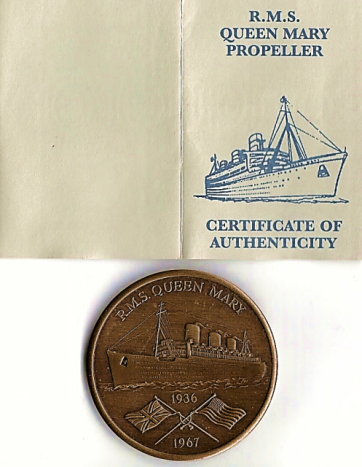Career of RMS Queen Mary (1934)
Trials and Maiden Voyage
The work on the ship was completed by 24 March 1936 and the Queen Mary sailed out of the Clyde as far as Arran for preliminary trials. After sailing to Southampton to be painted, the Queen Mary was handed over to Cunard on 11 May 1936.
The passenger accommodation emphasised the first two classes, cabin and tourist. The propulsion machinery of the ship produced a massive 160,000 SHP which gave it a speed of over 30 knots.
She made an inaugural cruise from Southampton on 14 May and then made her maiden voyage, on the Southampton-Cherbourg-New York route, on 27 May 1936.
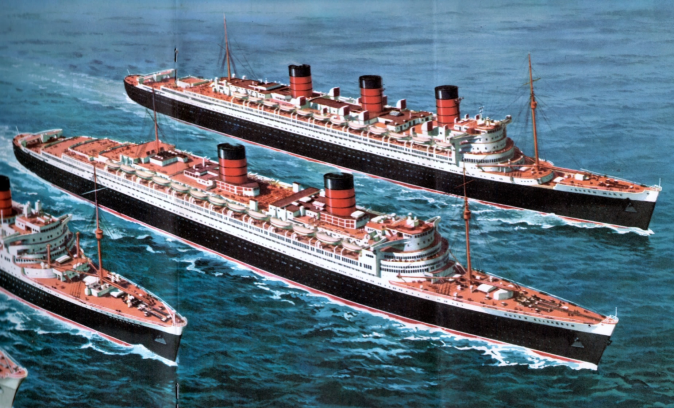
Despite expectations that the ship would try to break speed records on her first voyage, a thick fog destroyed any hope of this. In July, the Queen Mary spent a short time in dry dock whilst adjustments were made to the propellers and turbines. When she returned to service in August, she made a record voyage from Bishop's Rock to Ambrose light and took the Blue Riband from the SS Normandie.
The ship went into dry dock in December when alterations were made to the bulkheads. By May 1937, the Queen Mary had completed one year’s service and carried a total of 56,895 passengers. In August 1938, she regained the Blue Riband from the Normandie for a second time and set new records for both the eastbound and westbound crossings. She made her last commercial voyage from Southampton on 30 August 1939 and then remained berthed at New York until the end of the year whilst it was decided what role the ship would play during the war.
On 7 March 1940, the newly completed Queen Elizabeth arrived to join the Queen Mary, the Mauretania and the Normandie at New York.
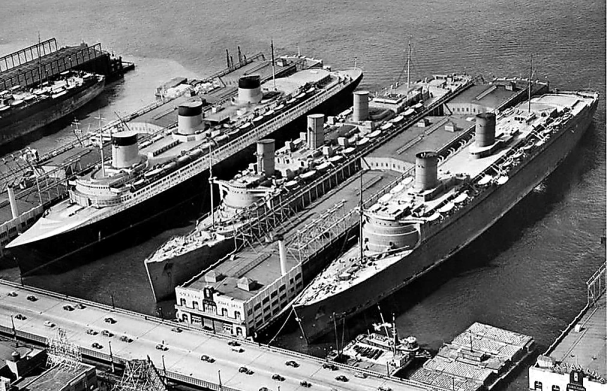
On 21 March 1940, the Queen Mary left New York under orders to sail to Cape Town and Sydney. On arrival, work began converting the ship into a troopship. Her luxury furnishings were removed and tiers of bunks and hammocks were substituted. Although small calibre guns were fitted on the ship, her main protection was speed.
On 4 May 1940, the Queen Mary left for the Clyde with 5,000 troops of the Australian Imperial Force on board. She arrived there on 16 June, and then sailed for Singapore carrying troops to bolster its defence in view of Japan's increasing threat. After an overhaul, she returned to Sydney and then made trooping voyages between there and India for the rest of the year.
The ship was dry-docked again in February 1941, where after she sailed between Australian ports and Singapore and Suez until November. As the Indian Ocean was becoming increasingly dangerous, with war looking imminent in the Far East and Pacific, the Queen Mary sailed to Boston where her trooping capacity was increased to 8,500 and heavier calibre guns and antiaircraft cannons were fitted.
After an urgent trip carrying US troops to Sydney, the Queen Mary's future role was to be on the North Atlantic. By late July in 1942, she had returned to New York. In the following months, she sailed to the Clyde and Suez and then returned to the USA with a complement of German POW's.
On 2 August 1942, she began a series of fast eastbound voyages carrying between 10,000-15,000 US troops at a time. On one of these voyages she had the worst collision of her career.
Collision with HMS Curacoa
The Queen Mary required an anti-aircraft escort when she approached the Clyde. Amongst her escort was the cruiser HMS Curacoa. On 2 October 1942, the escort ships were sighted. The Queen Mary was steaming at 28 knots in a zigzag pattern whilst the Curacoa, whose best speed was 26 knots, kept as close as possible. The Queen Mary overtook her escort and then resumed a zigzag pattern but the Queen Mary collided with the Curacoa close to its stern and sliced straight through the ship.
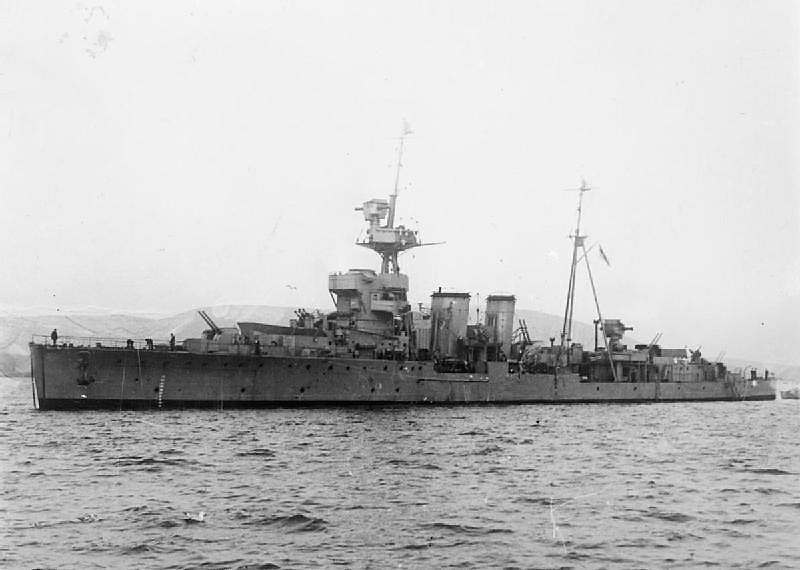
Of 430 crew members on the cruiser only 101 survived. Although damaged beneath the waterline the Queen Mary was able to continue. With over 11,000 troops on board, she could not stop to assist and sailed straight to the Clyde. A long legal battle between the Admiralty and Cunard eventually laid the blame equally on both vessels.
From October to December 1942, the Queen Mary underwent repairs at Boston and then returned to the Clyde. On 23 December, she sailed to Cape Town, Suez and Sydney carrying British troops to the Middle East and Australian troops back home. In April 1943, she returned to England and then berthed in New York in May. After this voyage she would remain as a ferry service for US troops for the remainder of the war. She is perhaps best remembered for this role.
Post Second World War career
On 2 September 1945, the Second World War ended. There was an urgent need to repatriate thousands of US combat troops from the conflict in the Pacific and Far East. The Queen Mary sailed to New York to be refitted and then began the long process of repatriation.
In January 1946, she began transporting GI brides to their new homes.
On 3 May, she transferred to Halifax to repatriate the wives and children of Canadian servicemen, which continued until the September.
On 27 September, the Queen Mary was handed back to Cunard. During her service she had travelled over 600,000 miles and carried nearly 800,000 people, mostly troops.
During a ten month refit at Southampton she was fitted with a new steam and air-conditioning system. The passenger accommodation was altered to house 711 First Class, 707 Cabin Class and 577 Tourist Class. On completion of the refit, she made her first sailing on 31 July 1947, from Southampton to New York. However, before the end of 1947, industrial disputes had started to affect the service.
Air travel was already becoming increasingly popular and many passengers were choosing to fly. On 1 January 1949, the Queen Mary ran aground at Cherbourg but was refloated and continued with her service.
On 11 July 1952, the SS United States took the Blue Riband from the Queen Mary with an average speed of 35.59 knots.
In March 1958, she was fitted with stabilisers by Denny-Brown but by the beginning of the next decade there was already speculation about her future. In December 1963, the Queen Mary made her first cruise to the Canaries and by 1965, she was well established as a cruise ship.
However, Cunard lost £4 million during a seamen's strike in May 1966, which hastened the end for the Queen Mary.
In 1967, a call at Cobh (formerly Queenstown until 1920) was added to the ship's Southampton to New York route, but the service was already losing thousands of pounds a day. She made her last transatlantic crossing on 16 September 1967 and there was much speculation about the future. In July 1967, Cunard announced it was to sell the liner to the town of Long Beach, California for £1,230,000.
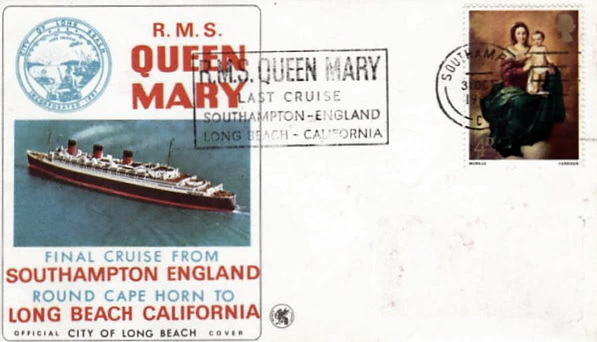
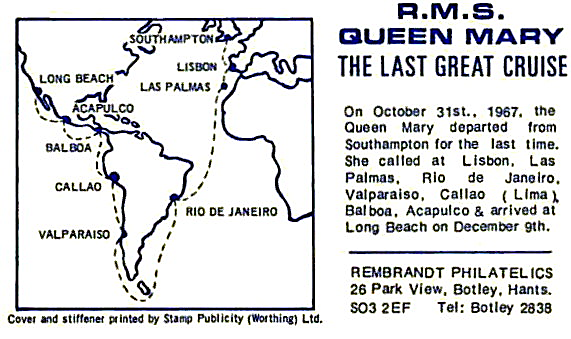
The Queen Mary is still berthed there today. Most of her machinery, including one of the two engine rooms, three of the four propellers, and all of the boilers, were removed. Coins and other mementos were minted from the ships propellers (pictured below).
Moored at Long Beach, the ship serves as a highly popular tourist attraction with restaurants, a museum and a hotel.
